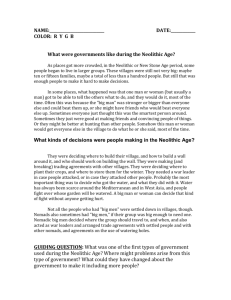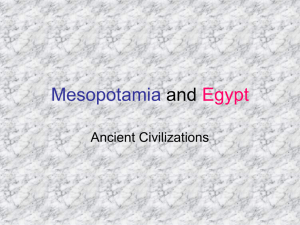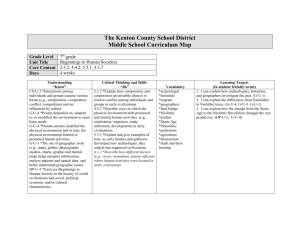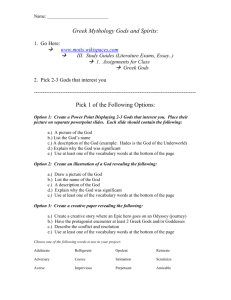Toward Civilization - Wappingers Central School District
advertisement
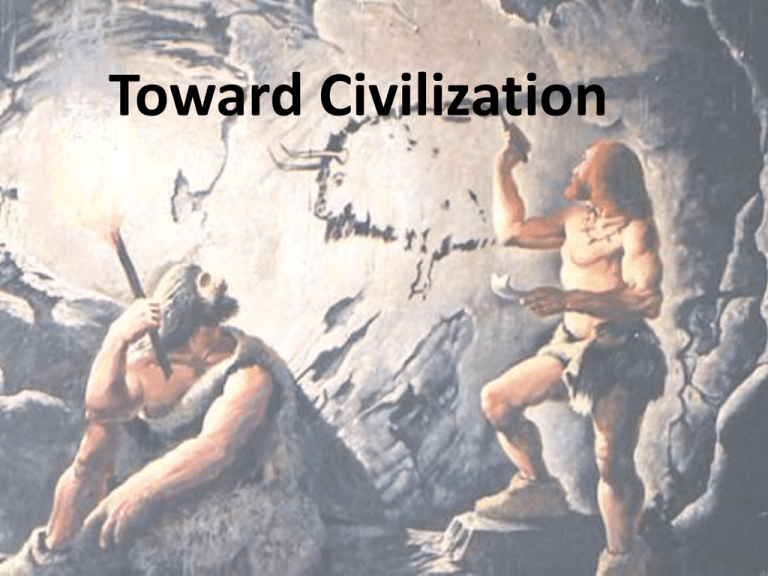
Toward Civilization Understanding Our Past • How Do We Know – Prehistory- The long period of time before people invented systems of writing. – 5,000 years ago some people in different parts of the world began to keep written records → The beginning of recorded history • Evidence From the Past – Archaeologists- Scientists who find and analyze the physical remains left by early people • Bone Fragments • Artifacts- tools and weapons, pottery, clothing or jewelry – Archaeology- Is a branch of Anthropology- The study of humans and the societies they created • Draw conclusions about beliefs, values, & activities of our ancestors. • Archeologists at work – Devised many useful techniques – Digging→ Further down they dig, the older the remains – Discovered how early people developed technology- skills and tools people use to meet their basic needs – Made detailed maps, locating every artifact they find • Technology and the Past – Modern technology helps interpret findings – Computers used to sort data – Aerial photography can reveal patterns of how people used the land – Radioactivity can determine the age of objects • Historians Reconstruct The Past – Historians- study how people lived in the past, but rely more on written evidence, ie, letters & tax records – Historical detection • Historians look for evidence to determine how reliable information is. • They often write about specific people from the past • Geography and History – Geography is the study of people, their environments and the resources available to them – Five themes of Geography • • • • • Location Place Human-Environment Interaction Movement Region • Location- Tells where a place is on the surface of the earth – Latitude- Measures distance North and South of the Equator – Longitude - Measures distance East and West of the Prime Medidian (imaginary line that runs North and South of Greenwich, England). • i.e. City of Seoul, South Korea is at 37⁰N latitude & 127 ⁰E longitude…..These numbers are the exact location – Relative Location- Where one place is located in relation to another. • i.e. Ancient Athens, was located on the Eastern Mediterranean Sea, near Egypt. • Place- Physical features and human characteristics – Physical Features- Land forms, body of water, climate, soil quality, resources, plant and animal life – CharacteristicsWhere most people live, economic activities, religious beliefs and languages • Human Enviornment Interaction-People are shaped by the place where they live • i.e. Early farmers used water from rivers to irrigate their crops • Movement- of people goods and ideas. Key link between geography and history – Nomads followed herds of deer, moved because of climate changes, traders carried goods • Region- geographers divide the world into many types of regions. – Some regions are based on physical features – Regions can also be defined by political, economic, or cultural features Dawn of History • Hunters and GathersHistorians call the earliest period of human history the Old Stone Age or Paleolithic Age – First tool makers, 10,000 BC • African Beginnings- 1959, Mary and Louis Leakey found pieces of bone embedded in Ancient rock at Olduvai Gorge, Tanzania – Found the bone belonged to early human – 1974, Donald Johanson found part of humanlike skeleton in Ethiopia. • Named his find “Lucy” after a Beatles song – Evidence shows the earliest humans came from East Africa – Their descendents later migrated east to Europe. • Nomads on the MovePaleolithic people lived in small hunting and food gathering bands, about 20 to 30 people – Everyone contributed to feeding the group • Men hunted and fished • Women cared for children, gathered fruit, nuts, shellfish – Nomads-People moved from place to place as they followed animals and ripened fruit • People depended on the environment • Made simple tools and weapons • At some point developed a spoken language • Environmental Changes – People faced severe challenges from the weather – During several ice ages the earth cooled – Thick glaciers -Sheets of ice that spread across parts of Asia, Europe, and North America • Paleolithic people invented clothing • Early Religion and Art – 30,000 years ago people began to leave evidence of their beliefs in the spiritual world – World was full of spirits especially those of the animals they hunted – Painted pictures were in the caves they lived in – Began to make statues Belief in the Afterlife- People began to bury their dead with great care – Left dead with tools, weapons and other needed goods • First Farmers • 11,000 yrs, ago nomadic herds learned to farm • Change from nomadic to settled farming began New Stone Age or Neolithic Age • Planting Seeds– Neolithic Agricultural Revolution- the transition from hunting and gathering to agriculture and settlement • Domesticating Animals – People learned to domesticate or tame animals that they once hunted. – People became food producers for the first time • Skara Brae, Neolithic Village – 5000 yrs, ago village in Scotland – Entire area was equal to the size of three classrooms • Each house was similar, people were equal in social class – People planted barley in fielded and tended animals – Farmers had workshops and developed specific jobs • Changing Ways of Life – Village leaders – People owned more possessions – New Technology • Learned to harvest at proper times • Civilizations emerged Beginnings of Civilization • Eight Features of Civilization • • • • • • • • Cities Well-Organized Central Governments Complex Religions Job Specifications Social Classes Arts and Architecture Public Works Writing • Rise of Cities – Farmers began cultivating fertile lands along river valleys and producing a surplus of goods • More food → More people → village became a city – River valley Civilizations • City Rose in: – Tigris and Euphrates, Middle East – Nile River, Egypt – Indus River, India – Yellow River, China • Floods spread silt across the valley, renewing the soil, keeping it fertile • Rivers gave regular water supply and a means for travel and trade – Challenges • Farmers had to control the floods • Early farmers worked together to build dykes, canals, and carve irrigation ditches – Civilizations in Americas • Aztecs and Incas emerged in the highlands of Mexico and Peru (Not near rivers) – Began as religious centers • Organized Governments – As cities grew they needed to maintain a steady food supply – At first priests had greatest power, warrior kings eventually became hereditary leaders, father → son – “Right to rule” came from the Gods – Rulers issued laws, collected taxes, organized defense – Royal officials enforced laws • Bureaucracies- system of managing government through departments run by appointed officials • Complex Religions – Polytheistic- Belief in many gods • Sun gods, river gods – Developed complex rituals, ceremonies for gods • Job Specifications and Social Classes – Urban people made new crafts, one person couldn’t be skilled at everything – Skilled artisans- (skilled craft workers) made pottery, metal working, weaponry, bricklayers – Social Ranking- People ranked according to jobs Priests and Nobles Wealthy Merchants Artisans and Soldiers Peasants Slaves • Arts, Architecture & Public Works – Expressed beliefs of the people – Statues of gods and goddesses, temple wall paintings – Government projects to make roads, irrigation systems, defense walls • Writing – Began in temples – Pictograms- Words represented by pictures – Became more complex, only specially trained people, scribes, learned to read and write • Spread of Civilizations – Rulers gained more power, conquered cities – City-states- A political unit that included a city and its surrounding lands and villages • First Empires – rulers conquered many city and villages, creating empires- group of cities or states controlled by one ruler • Interactions with Nomadic people – Nomads tended cattle on steppes- less fertile, sparse dry grasslands – Had to keep moving heard because of poor water – City people got along with nomads for political, economic or military matters – At times had conflicts Cultural Diffusion- The spread of ideas, customs and technologies from one people to another

